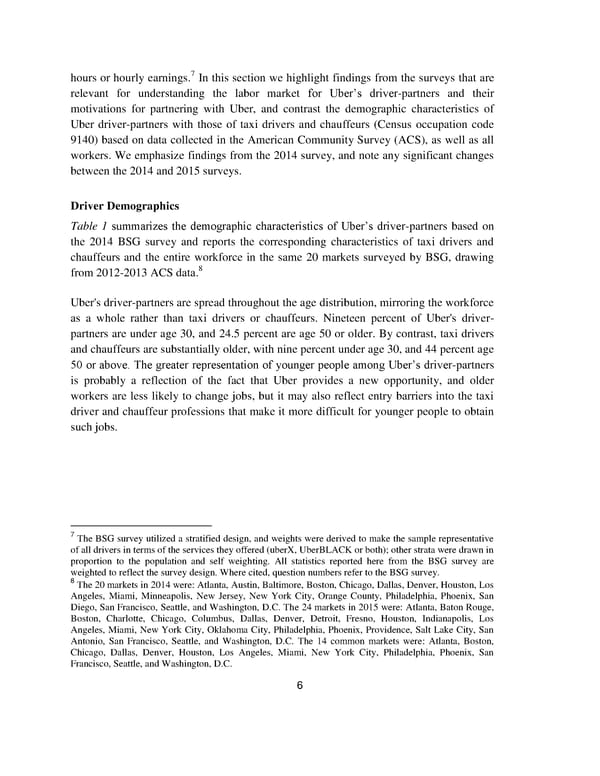hours or hourly earnings.7 In this section we highlight findings from the surveys that are relevant for understanding the labor market for Uber’s driver-partners and their motivations for partnering with Uber, and contrast the demographic characteristics of Uber driver-partners with those of taxi drivers and chauffeurs (Census occupation code 9140) based on data collected in the American Community Survey (ACS), as well as all workers. We emphasize findings from the 2014 survey, and note any significant changes between the 2014 and 2015 surveys. Driver Demographics Table 1 summarizes the demographic characteristics of Uber’s driver-partners based on the 2014 BSG survey and reports the corresponding characteristics of taxi drivers and chauffeurs and the entire workforce in the same 20 markets surveyed by BSG, drawing from 2012-2013 ACS data.8 Uber's driver-partners are spread throughout the age distribution, mirroring the workforce as a whole rather than taxi drivers or chauffeurs. Nineteen percent of Uber's driver- partners are under age 30, and 24.5 percent are age 50 or older. By contrast, taxi drivers and chauffeurs are substantially older, with nine percent under age 30, and 44 percent age 50 or above. The greater representation of younger people among Uber’s driver-partners is probably a reflection of the fact that Uber provides a new opportunity, and older workers are less likely to change jobs, but it may also reflect entry barriers into the taxi driver and chauffeur professions that make it more difficult for younger people to obtain such jobs. 7 The BSG survey utilized a stratified design, and weights were derived to make the sample representative of all drivers in terms of the services they offered (uberX, UberBLACK or both); other strata were drawn in proportion to the population and self weighting. All statistics reported here from the BSG survey are weighted to reflect the survey design. Where cited, question numbers refer to the BSG survey. 8 The 20 markets in 2014 were: Atlanta, Austin, Baltimore, Boston, Chicago, Dallas, Denver, Houston, Los Angeles, Miami, Minneapolis, New Jersey, New York City, Orange County, Philadelphia, Phoenix, San Diego, San Francisco, Seattle, and Washington, D.C. The 24 markets in 2015 were: Atlanta, Baton Rouge, Boston, Charlotte, Chicago, Columbus, Dallas, Denver, Detroit, Fresno, Houston, Indianapolis, Los Angeles, Miami, New York City, Oklahoma City, Philadelphia, Phoenix, Providence, Salt Lake City, San Antonio, San Francisco, Seattle, and Washington, D.C. The 14 common markets were: Atlanta, Boston, Chicago, Dallas, Denver, Houston, Los Angeles, Miami, New York City, Philadelphia, Phoenix, San Francisco, Seattle, and Washington, D.C. 6
 An Analysis Of The Labor Market For Uber’s Driver-partners In The United States Page 6 Page 8
An Analysis Of The Labor Market For Uber’s Driver-partners In The United States Page 6 Page 8